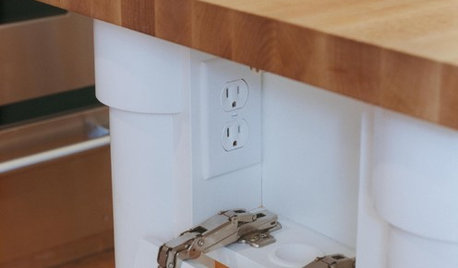non-polarized plug
ionized_gw
11 years ago
Related Stories

LIGHTING8 Ways to Use Plug-In Sconces in Your Lighting Scheme
Plug-in, wall-mounted sconces help unclutter desks, add visual interest and more. See if they are right for you
Full Story
GREEN BUILDINGOff the Grid: Ready to Pull the Plug on City Power?
What to consider if you want to stop relying on public utilities — or just have a more energy-efficient home
Full Story
KITCHEN DESIGNHow to Hide Those Plugs and Switches
5 ways to camouflage your outlets — or just make them disappear
Full Story
LIFEHouzz Call: How Are You Handling the Record-Breaking Cold?
Share your tales, strategies and photos for everything polar vortex
Full Story
HOUSEKEEPINGLower Your Heating Bills With Some Simple Weather Stripping
Plug the holes in your house this winter to make sure cold air stays where it belongs: outside
Full Story
MOST POPULARShould You Keep Your Tub?
There are reasons to have a bathtub, and plenty of reasons not to. Here’s how to decide if you should keep yours or pull the plug
Full Story
DECORATING GUIDESPaint it Black
For Non-Color Riches, Go Dark on a Wall, the Floor — or All Over
Full Story
FURNITUREWhat to Know Before You Buy a Sectional
Learn about sizes, arm setups, seat types and more to get the right sectional for your space
Full Story
GREEN BUILDINGInsulation Basics: Designing for Temperature Extremes in Any Season
Stay comfy during unpredictable weather — and prevent unexpected bills — by efficiently insulating and shading your home
Full Story
GREAT HOME PROJECTSPower to the People: Outlets Right Where You Want Them
No more crawling and craning. With outlets in furniture, drawers and cabinets, access to power has never been easier
Full StoryMore Discussions








Ron Natalie
ionized_gwOriginal Author
Related Professionals
Aberdeen General Contractors · Alhambra General Contractors · Bay Shore General Contractors · Clarksville General Contractors · Dorchester Center General Contractors · Hampton General Contractors · Mount Laurel General Contractors · Pasadena General Contractors · Rolling Hills Estates General Contractors · La Mirada Solar Energy Systems · Moreno Valley Solar Energy Systems · Selma Solar Energy Systems · Boston Home Automation & Home Media · Brookfield Home Automation & Home Media · Silver Spring Home Automation & Home Medialbpod
ionized_gwOriginal Author
brickeyee
bus_driver
alan_s_thefirst
bus_driver
ionized_gwOriginal Author
brickeyee
w0lley32
bus_driver
brickeyee
ionized_gwOriginal Author
lbpod
brickeyee
bus_driver